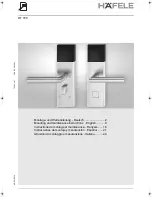
7
I
GB
F
E
NL
D
FIG.13
FIG.14A
FIG.14B
FIG.15
ASSEMBLING THE STRIKER:
Latch-bolt main casing (1 side point or anyway whenever present).
12) Position the doorstop strikers on the latch-bolt using the necessary number of spacers
to respect the distance indicated in Figs. 14A and 14B; mark with an awl the two side
holes (slots) and drill the two holes H3 = 2.6 mm (indicative for aluminium profiles) (Fig.
13).
ATTENTION:
adjust the position of the striker so that the anti-picking device lever,
with the door closed, is completely pressed down and flush with the latch-bolt. If this
is not the case the dead-locking device of the latch-bolt will not be active (Fig. 13).
13) Press down the bar, open the door and check that the casing/striker passageway is free
of any kind of obstacles.
14) Drill the third hole H5 = 2.6 mm and fix the striker permanently (Fig. 15).
MONTAGE DE LA GÂCHE:
12) Positionner les gâches contre le pêne en utilisant le nombre d’épaisseurs nécessaires
pour respecter la distance indiquée dans les fig. 14A et fig. 14B; Marquer avec un
poinçon les deux trous latéraux (rainures) et réaliser les deux trous H3 = 2,6 mm
(indicatif pour les profils en aluminium) (fig. 13).
ATTENTION:
régler la position de la gâche de manière à ce que le doigt anti-effraction,
quand la porte est fermée, soit complètement enfoncé et au niveau du pêne. Dans le cas
contraire, le dispositif de blocage du pêne ne sera pas actif (fig. 13).
13) Appuyer sur la barre pour ouvrir la porte et vérifier que le passage carter/gâche est libre
de tout talonnage ou forçage.
14) Réaliser le troisième trou H5 = 2.6 mm et fixer définitivement la gâche (fig. 15).
MONTAJE DEL BATIENTE:
12) Coloque los batientes en correspondencia con el pestillo, utilizando el número de
espesores necesarios para respetar la distancia indicada en las figuras 14A y 4B;
marque con un punzón los dos orificios laterales (ojales) y practique los dos orificios
de 2,6 mm (indicativo para los perfiles de aluminio) (Fig. 13).
ATENCIÓN:
regule la posición del batiente de tal modo que la palanca anti-picking, con
la puerta cerrada, quede completamente apretada y al ras del pestillo. En caso contrario,
el dispositivo de bloqueo del pestillo no estará activo (Fig. 13).
13) Apriete la barra, abra la puerta y verifique que el pasaje entre el cárter y el batiente no
presente atascamientos ni forzamientos.
14) Practique el tercer orificio de 2,6 mm y fije definitivamente el batiente (Fig. 15).
MONTAGGIO BOCCHETTA:
12) Posizionare le bocchette a battuta sullo scrocco utilizzando il numero di spessori
necessari per rispettare la distanza indicata nelle fig. 14A e fig. 14B; Segnare con un
punteruolo i due fori laterali (asole) ed eseguire i due fori H3 = 2,6 mm (indicativo per
profili di alluminio) (fig. 13).
ATTENZIONE:
regolare la posizione della bocchetta in modo che la levetta antiscasso,
a porta chiusa, risulti completamente premuta ed a filo con lo scrocco. In caso contrario
il dispositivo di bloccaggio dello scrocco non sarà attivo (fig. 13).
13) Premere la barra aprire la porta e verificare che il passaggio carter/bocchetta sia libero
da impuntamenti o forzature.
14) Eseguire il terzo foro H5 = 2.6 mm e fissare definitivamente la bocchetta (fig. 15).
Battuta lineare (in dotazione)
Linear doorstop (supplied as standard)
Butée linéaire (fournie)
Batiente plano (en dotación)
Lineaire aanslag (standaard geleverd)
Gerader Anschlag (im Lieferumfang enthalten)
Battuta ad angolo (non in dotazione, articolo 07072.21.0 da ordinare a parte)
Corner doorstop (not supplied as standard, item 07072.21.0 to be ordered
separately)
Butée à angle (pas fourni, article 07072.21.0 à commander à part)
Batiente angular (no suministrado, artículo 07072.21.0 para ordenar a parte)
Hoekaanslag (niet bijgeleverd, artikel 07072.21.0 apart te bestellend)
Winkeliger Anschlag (nicht im Lieferumfag enthalten, Artikel 07072.21.0 separat zu
bestellen)
6
6 - 9
9
6 - 9
6 - 9
MONTAGE DER BESCHLÄGE:
12) Die Bechläge in Überinstimmung mit der Falle positionieren, dazu verwendet man die
notwendige Anzahl an Ausgleichscheiben, um den auf den Abb. 14A und Abb. 14B
angeführten Abstand einzuhalten. Mit einem Senkstift die beiden seitlichen Bohrungen
(Schlitze) anzeichnen und die beiden Bohrungen H3=2.6 mm durchführen (die angeführten
Durchmesser beziehen sich auf Aluminiumprofile) (13).
ACHTUNG:
Position des Beschlags
so regulieren, dass der Einbruchsicherungshebel bei geschlossener Tür vollständig gedrückt
ist und mit der Falle in einer Linie steht. Wenn diese Voraussetzungen nicht vorhanden sind,
ist die Sperrvorrichtung der Falle nicht aktiv. (Abb. 13).
13) Stange drücken, Tür öffnen und sicherstellen, dass die Passage von Haube/Beschlag frei
von Behinderungen und Druckbewegungen ist.
14) Die dritte Bohrung H5=2.6 mm durchführen und den Beschlag endgültig befestigen (Abb.
15).
MONTAGE VAN DE SCHOOTPLAAT:
12) De schootplaat op de schoot plaatsen, en de nodige tussenstukken aan brengen om de
in afb. 14A en 14B aangegeven afstanden in acht te nemen. De twee zijgaten markeren
en de gaten H3 = 2,6 mm boren (voor aluminiumprofielen) (afb. 13).
LET OP:
de positie van de schootplaat zodanig regelen dat de inbraakbeveiliging, met
gesloten deur, volledig ingedrukt in lijn met de schoot is. Zo niet zal het vergrendelsysteem
van de schoot niet werken (afb. 13).
13) Op de anti-paniek duwstang duwen om de deur te openen en controleren dat de ruimte
carter/schootplaat vrij van opstoppingen is en niet forceert.
14) Een derde gat H5 = 2,6 mm boren en de schootplaat definitief bevestigen (afb. 15).


























